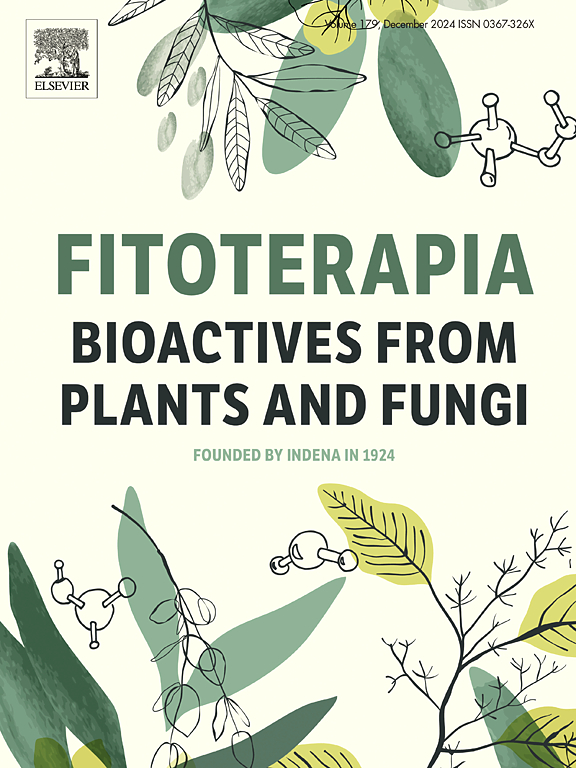Tissue distribution of seven coptidis alkaloids in normal and insomnia rats affected by Cinnamomi cortex (Cinnamomum cassia) using liquid chromatography-tandem mass spectrometry
IF 2.6
3区 医学
Q3 CHEMISTRY, MEDICINAL
引用次数: 0
Abstract
Jiao-Tai-Wan (JTW), composed of Coptidis Rhizoma (CR) and Cinnamomi Cortex (CC) in a 10:1 ratio (w/w), is an ancient prescription effectively used for treating insomnia in China. The pharmacodynamic components of JTW are primarily coptidis alkaloids from CR; however, the therapeutic mechanism remains unclear now. This study aimed to discuss the effects of CC on pharmacokinetic characteristics of CR by analyzing the tissue distribution of seven main coptidis alkaloids. A liquid chromatography-tandem mass spectrometry (LC-MS/MS) method was established to simultaneously quantify the contents of these seven coptidis alkaloids in tissues. The tissue distribution and pharmacokinetic profiles of these alkaloids were investigated in both normal and insomniac rats treated with CR alone or JTW. The LC-MS/MS method demonstrated high reproducibility and accuracy upon validation. Coptidis alkaloids were predominantly distributed in the heart, liver, and kidneys. Berberine was the most accumulated component in all tissues, while magnoflorine and berberrubine mainly accumulated in the liver and kidneys, respectively. There were significant differences in the distribution pharmacokinetic parameters of coptidis alkaloids between normal and insomniac rats (p < 0.05). The combination of CR and CC reduced the accumulation of coptidis alkaloids in normal rats and significantly increased it in insomniac rats (p < 0.05). These findings suggest that tissue distribution characteristics of coptidis alkaloids can be altered in a state of insomnia and after compatibility, the accumulation of alkaloids can be increased in vivo. This study reveals the pharmacokinetic interaction between CR and CC from the perspective of tissue distribution and provides valuable insights into the rationality of the combination of CR and CC and the mechanism of JTW in treating insomnia.

用液相色谱-串联质谱法研究桂皮对正常和失眠大鼠黄连7种生物碱的组织分布。
胶台丸(JTW)由黄连(CR)和肉桂皮(CC)以10:1的比例(w/w)组成,是中国一种有效治疗失眠的古老方剂。复方黄连的药效学成分主要为黄连生物碱;然而,其治疗机制目前尚不清楚。本研究通过分析黄连7种主要生物碱的组织分布,探讨黄连对黄连药代动力学特性的影响。建立了液相色谱-串联质谱法(LC-MS/MS)同时定量测定组织中7种黄连生物碱含量的方法。研究了这些生物碱在正常大鼠和失眠大鼠体内的组织分布和药代动力学特征。经验证,LC-MS/MS方法具有较高的重现性和准确性。黄连生物碱主要分布于心、肝、肾。小檗碱是各组织中积累最多的成分,而木兰花碱和小檗碱分别主要积聚在肝脏和肾脏。失眠大鼠与正常大鼠黄连生物碱分布药动学参数差异有统计学意义(p
本文章由计算机程序翻译,如有差异,请以英文原文为准。
求助全文
约1分钟内获得全文
求助全文
来源期刊

Fitoterapia
医学-药学
CiteScore
5.80
自引率
2.90%
发文量
198
审稿时长
1.5 months
期刊介绍:
Fitoterapia is a Journal dedicated to medicinal plants and to bioactive natural products of plant origin. It publishes original contributions in seven major areas:
1. Characterization of active ingredients of medicinal plants
2. Development of standardization method for bioactive plant extracts and natural products
3. Identification of bioactivity in plant extracts
4. Identification of targets and mechanism of activity of plant extracts
5. Production and genomic characterization of medicinal plants biomass
6. Chemistry and biochemistry of bioactive natural products of plant origin
7. Critical reviews of the historical, clinical and legal status of medicinal plants, and accounts on topical issues.
 求助内容:
求助内容: 应助结果提醒方式:
应助结果提醒方式:


